Tags: urban planning
Walk up North Mound
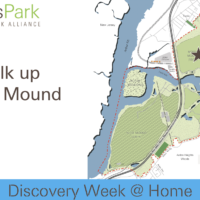
At 2,200 acres, Freshkills Park is almost three times the size of Central Park and the largest park to be developed in New York City in over 100 years. It also has a significant history as the site of the Fresh Kills Landfill, which was the largest landfill in the world before closing in 2001.
...MOREFreshkills Park, Without Borders
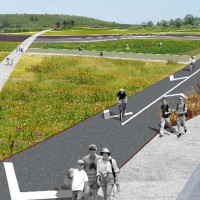
Where does a park end and a neighborhood begin? For many parks in New York City, the line has been pretty rigid. Tall gates and fences have separated a number of the city’s parks and playgrounds from adjoining sidewalks, creating literal and symbolic divides between people and green spaces.
...MOREUrban Omnibus: “Ted Nabavi Turns Hazards into Riches”

“I always wanted to get into environmental science to clean up hazardous waste,” Ted Nabavi said in his recent interview with Urban Omnibus. Ted has been working with DSNY for over 25 years, currently as the Director of Waste Management Engineering for the Bureau of Solid Waste Management.
...MOREFarther Afield: Tianjin Eco-city
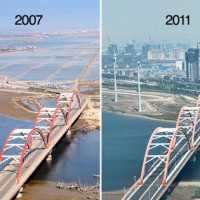
Located just a short drive outside of Beijing is a new city in development. Tianjin is one example of the several planned Eco-cities in China, where sustainable cities have become a relatively popular urban planning typology for formerly polluted areas. In the case of Tianjin, the one square mile reservoir was used to store a brine water solution containing Mercury and DDT, which damaged the area’s ecological functions.
...MOREFarther Afield: NYC Curbside Gardens

Well known to city dwellers, the urban landscape is dominated by impervious hard surfaces that require manmade sewage infrastructure to handle all rainfall and storm water management. In normally functioning environments, soil and vegetation absorbs this water and retains it to a certain capacity before runoff is generated.
...MORENew Recycling Facility Demonstrates Sustainability
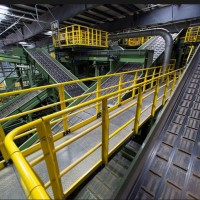
Designing Resilient Streets
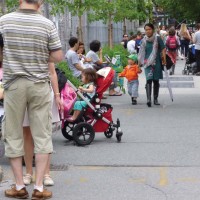
How do you design a space to maximize its social and ecological resiliency? A green space where the community gathers and plants help clean the air and absorb storm water. You might think that such a space could only be achieved in a large park like Freshkills, but the newly released 2013 Street Design Manual demonstrates how the street in front of your doorstep can be transformed into a place that fosters social interactions and supports wildlife.
...MORESneak Peak 2013
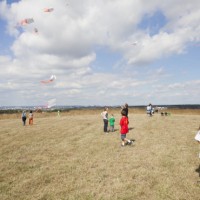
On September 29th, Freshkills Park opened its gates to the public for the fourth annual Sneak Peak event and attracted 3,500 people, a steady increase from previous years.
They came on bikes, on ferries, and in cars; with family, with friends.
...MOREFeeding Cities
The complex relationship between cities and agriculture was a hot topic this spring at the “Feeding Cities” conference at the University of Pennsylvania. Growing populations are demanding more food, as well as increasing the geographic footprint of cities. Once fertile land on the outskirts of cities is being developed, and agriculture has become dominated by large scale corporate farming, which further complicates food distribution issues.
...MOREComposting Toilets in New York City
Prospect Park is building a composting toilet and putting to use an obsolete building. The Pump House, an unused building tucked away in the center of the park, is not connected to the New York City sewer system so traditional restrooms are not possible but with park use on the rise more restroom facilities are needed, especially in this more remote area of the park.
...MOREHighlighting another Sustainable Park: Canal Park, Washington DC
Canal Park in Washington DC, situated between the Anacostia and Potomac Rivers, was originally a canal before it was paved over in the early 1900’s for a multitude of uses, including use as a lot for idling buses. The area was converted into a park in 2000 and shortly thereafter, in 2004, the non-profit Canal Park Development Association sponsored a sustainable park design competition for the site.
...MORETransforming Berlin’s Tempelhof Airport
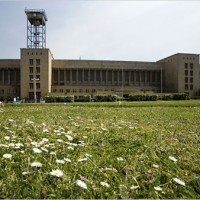
In 2010, two years after its closure, Berlin’s Tempelhof Airport was reopened to the public as Tempelhofer Freiheit, a large city park just two miles south of the city center. Since it’s reopening, little has been done to the airport’s landscape; existing walkways are largely disconnected and only minimal infrastructure and amenities are in place.
...MORENew study on link between trees and lower crime rates
Previous studies have shown that trees are associated with lower crime rates and a new study in Baltimore affirms this finding, showing the link goes beyond a correlation between the two factors. In other words, it’s not just a matter of wealthier neighborhoods having lower crime rates.
...MORENew Section of Staten Island Bike Path to Open in August
Come August, Staten Island is set to become an even more bike-friendly borough. The Parks Department is in the process of completing a two-mile bike path that will connect the neighborhoods of Great Kills and New Dorp, both of which lie on the other side of Latourette Park from Freshkills Park.
...MOREHow building subways helps build our parks
As work on Manhattan’s Second Avenue subway line progresses, those viewing the massively scaled operation may wonder, “where does all the excavated dirt and rock go?” In the past, the ‘muck’ from expanding subway lines and other construction projects has contributed to the building of Ellis Island, Governors Island and Battery Park City, among other city landmarks – including the expansion of the Manhattan shoreline.
...MOREBioswales and green infrastructure for New York
The future of green infrastructure within the New York metropolitan region just got brighter: NY State and City officials announced this week that over $2 billion in public and private investments would be committed to ecologically-sound techniques for the management of stormwater runoff and sewage overflow.
...MORELAGI Field Guide to Renewable Energy Techonologies
The Land Art Generator Initiative (LAGI) team recently announced the release of their Field Guide to Renewable Energy Technologies, a free resource they hope will prove useful to “all designers, homeowners, urban planners, students, artists, architects, landscape architects, engineers, and anyone else interested in a clean energy future”.
2012 Land Art Generator Initiative
Earlier this month, the 2012 Land Art Generator Initiative (LAGI) ideas competition, in partnership with New York City’s Department of Parks & Recreation, opened with a call for large-scale artwork proposals with the ability to generate renewable energy for New York City.
...MOREImagining an NYC park in an underground vestige
With landscape architects riding a wave of creative post-industrial reimagination in New York City–rail lines, concrete plants and landfills are all turning green–it was perhaps inevitable that underground park spaces were next. And so it goes that a team of design speculators have taken on the challenge of re-envisioning the Lower East Side’s former Williamsburg Bridge Trolley Terminal as a sun-lit subterranean park, dubbed “The Delancey Underground.”
...MORE



